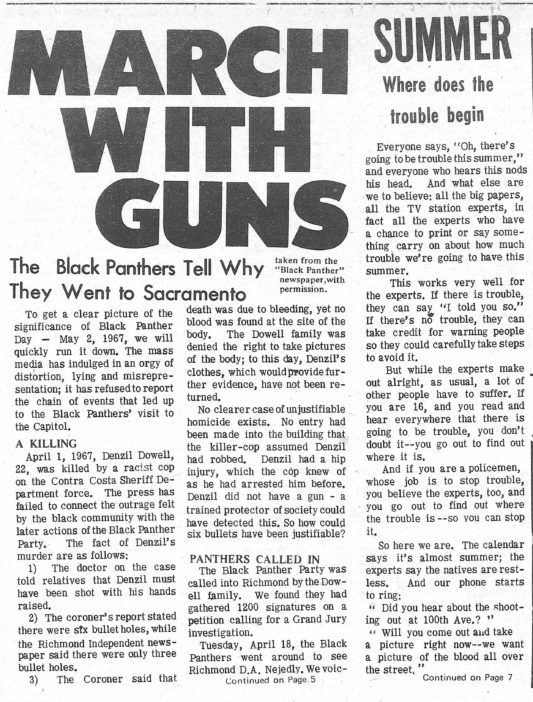Two articles sit on the front page of the June 15, 1967 edition of The Flatlands: the piece “Summer: Where Does the Trouble Begin” and “March With Guns: The Black Panthers Tell Why They Went to Sacramento” (reprinted from The Black Panther newspaper, with permission). The two articles suggest the growing relationship between The Flatlands and the Black Panther Party for Self-Defense (BPP), as dual organizations emerging out of Oakland’s “flatlands” and committed to fighting police brutality.
The Party’s April 1967 armed march on the California State Capitol in Sacramento (organized in response to the killing of Denzil Dowell by Richmond police) made headlines worldwide, and Flatlands contributor Mark Comfort had played a key role in the story. Following an impromptu community rally in Dowell’s North Richmond neighborhood, Comfort had driven to the BPP offices in North Oakland to enlist their aid, and he had been among the marchers arrested following the rally in Sacramento.
***
The Castlemont riots of the previous fall had come and gone, but in Oakland the fear of urban unrest aggravated by hot weather remained. Community-police relations had, if anything, degenerated in the months since. The Oakland Police Department had responded to the BPP’s armed community patrols with hostility, and the Panthers’ increasingly strident denunciations of police conduct had earned them widespread credibility and support in the East Bay’s black communities. Among black residents of the East Bay the killing of Denzil Dowell may have been the incident closest to mind in defining attitudes toward the police in the spring of 1967, but it was far from the only one.
Another complaint against the Richmond Police Department, for example, arose from the May beating of Clarence Young. Young reported that he and a group of friends, after running out of gas, were accosted by patrolling officers while pushing the car down the street. After identifying him by name and asking him for identification, an officer struck Young on the head, threw him over the trunk of the car, and arrested him. Alongside his testimony, which announced a $100,000 lawsuit against the RPD, are photos of Young’s lacerated head and the bloodstains on his car from the assault. In closing, the author archly expresses the wish that “the police would try not to think of all the trouble this summer, would try not to let the possibility of “riots” come in to their minds every time they make an arrest in the flatlands or anywhere.”
